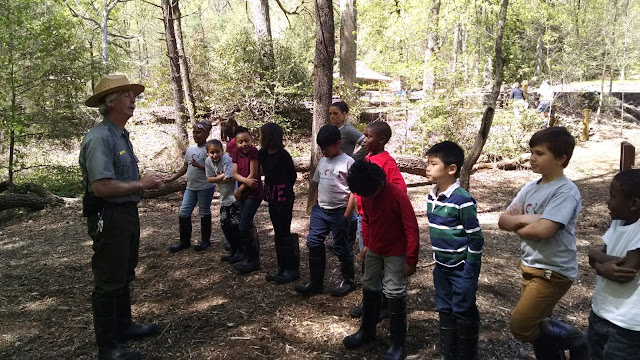We finished with a little year-in-review game. Students answered some systems questions using Kahoot and their responses earned them some positive or not-so-positive inputs to their forest and pond snack ecosystems. A little acid rain with that dirt dessert?!? :) I don't think there exists a quirkier, brighter, sweeter, or more fun group of kids! I can't say enough how much I have enjoyed my Fridays this year! They will surely be missed!
Friday, May 20, 2016
Gray Area Conclusion
We've made it to the end of our Gray Area investigations. Students have looked at acid rain, chlorine, sediments, phosphates, and oil as possible culprits in our mystery. Today we had an emergency board meeting to go over all the evidence and draw conclusions about the most likely reasons for the dying fish. Students justified their votes with evidence and found that the answer wasn't as cut and dry as they may have thought. As in real life, with so many elements at play, there is often a lot of "gray area" when it comes to making the best choices for us and our environment. We also looked at possible solutions to the problems we've discovered and pros and cons of those as well. I was proud of all of the students work, ideas, ability to think through different layers of the issues, and the connections they made to our overarching systems theme.
We finished with a little year-in-review game. Students answered some systems questions using Kahoot and their responses earned them some positive or not-so-positive inputs to their forest and pond snack ecosystems. A little acid rain with that dirt dessert?!? :) I don't think there exists a quirkier, brighter, sweeter, or more fun group of kids! I can't say enough how much I have enjoyed my Fridays this year! They will surely be missed!
We finished with a little year-in-review game. Students answered some systems questions using Kahoot and their responses earned them some positive or not-so-positive inputs to their forest and pond snack ecosystems. A little acid rain with that dirt dessert?!? :) I don't think there exists a quirkier, brighter, sweeter, or more fun group of kids! I can't say enough how much I have enjoyed my Fridays this year! They will surely be missed!
Friday, May 6, 2016
Phosphates and Algal Blooms
Our Gray Area investigators were hot on a new trail today as they conducted various tests to determine if phosphate from fertilizer or manure might be causing an algal bloom in James Pond. With their eyes on the cattle ranch, small town, and golf course, they discovered algal blooms result from excessive algae growth and as the overabundant algae rots away it causes bacteria to use up all the oxygen in the water and causes negative effects on fish populations. Ask your student who we discovered our new leading suspect to be!
Friday, April 29, 2016
Population Boom
Today we joined forces with our Monday third graders and investigated an interesting connection between the sediment problem from last week and the mountain lion hunting occurring in the area. Students played a game to simulate the fluctuation in the deer population with and without predators. They found that mountain lion hunting in the area reduces predators for deer and their population is able to experience booms and crashes. On these booms, they overgraze and reduce ground cover resulting in more erosion than usual.
Friday, April 22, 2016
Turbidity
Today students considered another factor that may be causing problems for fish in Gray Area. With logging an active business in the area, some of the rivers were looking a little dirty. Students used secchi disks to determine the clarity, or turbidity, of the water in the various lakes and rivers in the area. They then examined the sediment files to understand the effects of erosion and high levels of sediments on the organisms living there.
We also enjoyed participating in the Pathfinder Challenge, completing a self-reflection, and soaking in some sun with Listening to Crickets.
We also enjoyed participating in the Pathfinder Challenge, completing a self-reflection, and soaking in some sun with Listening to Crickets.
Friday, April 15, 2016
Acid Rain Continued...
We've used our research skills to uncover the solution to our curious acid rain test results! Although the rain over the entire Gray Area is acidic, only some of the waterways are unhealthy for fish due to pH. Students found that part of the Gray Area has large amounts of limestone that neutralize the acid and make the water livable for fish. They also discovered that the Gray area acid rain problem is largely cause by cars and trucks, clearing the Toy Factory as a prime suspect. We also spent time discovering possible solutions to the acid rain problem.
Creativity was also a focus. Students used originality and design thinking to develop a perfect hat to help our friends the Ats who are plagued by pesky gnats! Take a look at some of their clever ideas!
We also did some reflection and systems review as students completed their field study packets and shared some favorite take-aways.
Also, we enjoyed Sandstorm, our special class visitor!
Wednesday, April 6, 2016
Jones Gap Field Study
We had a wonderful learning experience at Jones Gap! Students explored the river and forest systems of the park. They were able to use field guides for plant and animal identification, conduct several water quality tests, and understand the important interactions between the two habitats. Thanks to all our wonderfully behaved students and fantastic chaperons!
Friday, March 25, 2016
Jones Gap Preparation
Third graders embark the week after spring break on our mountain trip to Jones Gap State Park. We spent today preparing by doing some vocabulary review. Students can continue to practice the must-know terms at this link. We also looked at water quality test we will conduct at the park, layers of the forest, and life cycles of some of the macro-invertebrates we hope to find. Students did a great job researching and composing their expert cards highlighting one of the many living organisms that calls Jones Gap home. Take a look at their work!
Delany- Fetterbush
Srianeesh- Eastern Hemlock
Makell- Sassafrass
Brianna- Tulip Poplar
Kevin- Wild Violet
Kathleen- Foam Flower
Ivan- Sourwood
Rohan- American Beech
Delany- Fetterbush
Srianeesh- Eastern Hemlock
Makell- Sassafrass
Brianna- Tulip Poplar
Kevin- Wild Violet
Kathleen- Foam Flower
Ivan- Sourwood
Rohan- American Beech
Subscribe to:
Posts (Atom)














































